So You Want to Play 'Magic: The Gathering'
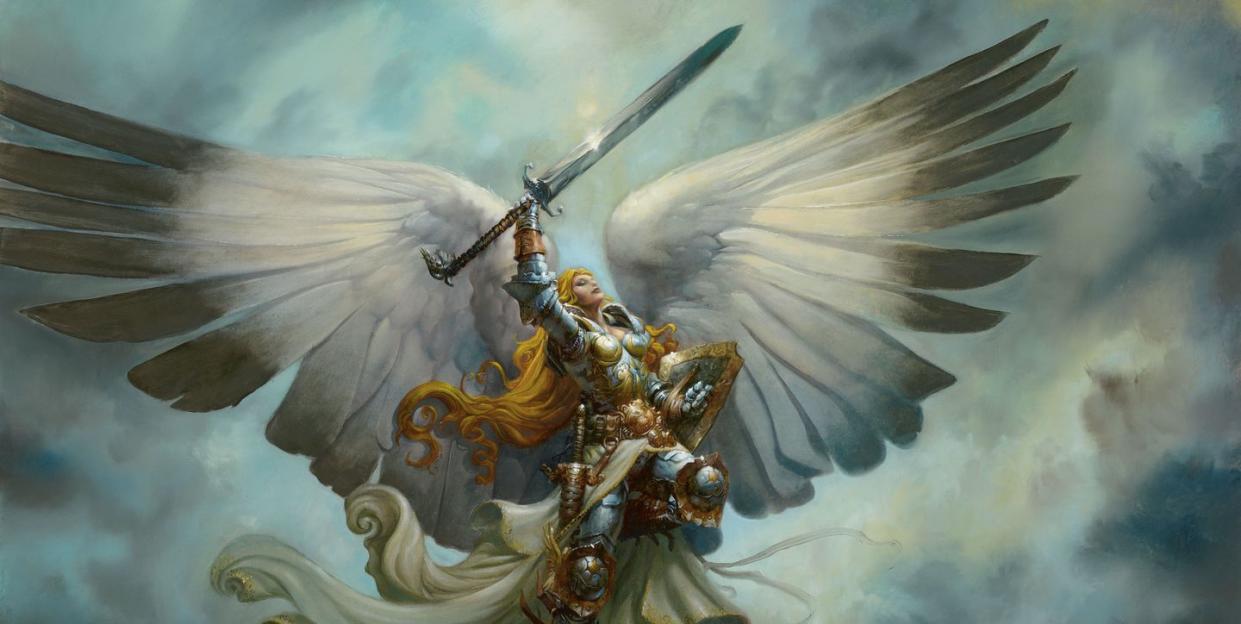
In August 1993, Richard Garfield and Wizards of the Coast released the Alpha set of Magic: The Gathering. Eighty-four expansions and 25 years later, Magic has grown into a cultural behemoth and remains the original inspiration for many of the collectible card games that followed, from Yu-gi-oh to Hearthstone.
But like Wizards’ other storied fantasy game—Dungeons & Dragons—all that history comes with a lot of rules. Those rules ultimately make Magic: The Gathering an ever-changing game that entices new players and feeds those already hooked on its method of storytelling and gameplay. They can also make the journey for a beginner a harrowing one. Glancing at your average Magic card, especially one not found in Magic’s beginner-friendly sets, is intimidating to say the least, as the cards can be filled with enough jargon to make the game seem incomprehensibly difficult.
“When I’ve talked with Richard Garfield, the game's creator, about Magic, he always says ‘easy to learn, difficult to master,’” says Gavin Verhey, former professional Magic player and current senior game design and product architect for Wizards. “You can pick it up and play it…but man there is so much cool stuff to learn as you get deeper and deeper.”
With that in mind, here’s how to get started with Magic without getting lost in the game's quarter-century of rules:
Know Your Colors
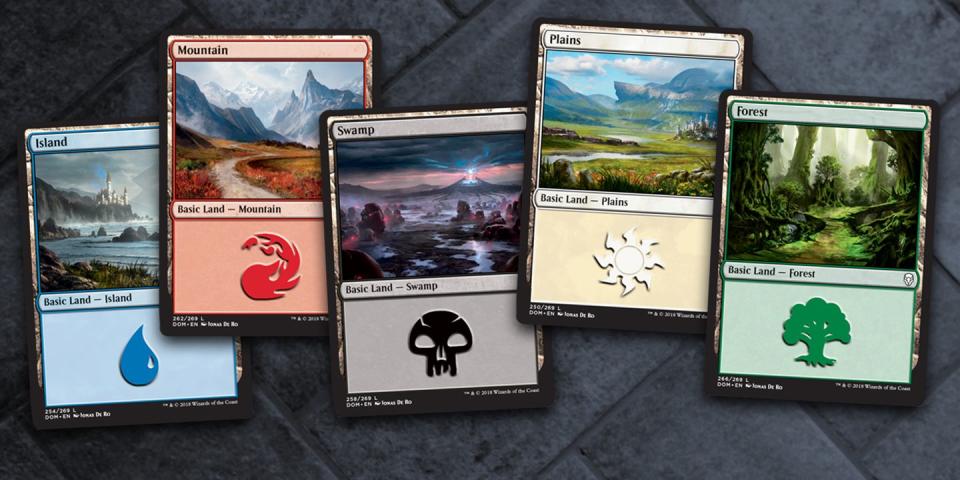
At its most basic, Magic is actually very simple. You and a friend(s) are Planeswalkers, powerful beings who can traverse different planes of existence and do battle by summoning powerful spells. With 20 hit points each, the goal is win by drawing powerful spells and creature spells that can lower your opponent’s life total while sustaining your own hitpoints. The first player whose life total reaches zero loses.
To summon these spells, you rely on what are called land cards, or mana. These lands and their coordinating colors represent the very basic building blocks of Magic, and there are five types of land cards, each representing a natural landscape that dictates the flavor of that particular spell:
Islands: This blue mana is often associated with knowledge and foresight, casting spells that interrupt the other player or help you draw cards faster. Creatures are often wizards, merfolk, or spirits.
Mountains: This red mana casts aggressive spells and creatures meant to beat your opponent by the quickest means necessary. Red spells like Fireball and Lightning Bolt along with creature types like goblins and warriors make for fast games.
Swamps: Black mana is the most sinister of the bunch. In these decks, you’ll often find spells capable of leeching away your opponent’s health while relying on zombies, demons, and other infernal creatures to finish the job.
Plains: On the opposite side of the spectrum, white mana represents civilization. Many of its creatures are soldiers, clerics, and knights, and its spells focus on increasing the health and the attack of your minions (also known as buffs) or healing them (or yourself) instead.
Forests: Like the topography of its namesake, this green mana exudes raw natural energy, relying on aggressive buffs and all manner of beasts, elves, and druids of the wood to bring you victory.
While most creatures and spells will sport one of these colors, there are some exceptions. Multi-colored cards, as the name suggests, often overlap with two colors (a vampire cleric would be a good white/black card for example) and requires both color land to play the card.
Colorless cards have no assigned color, meaning any type of land can be played to summon these types of creature spells, which are often golems, constructs, and various automata.
Know Your Cards
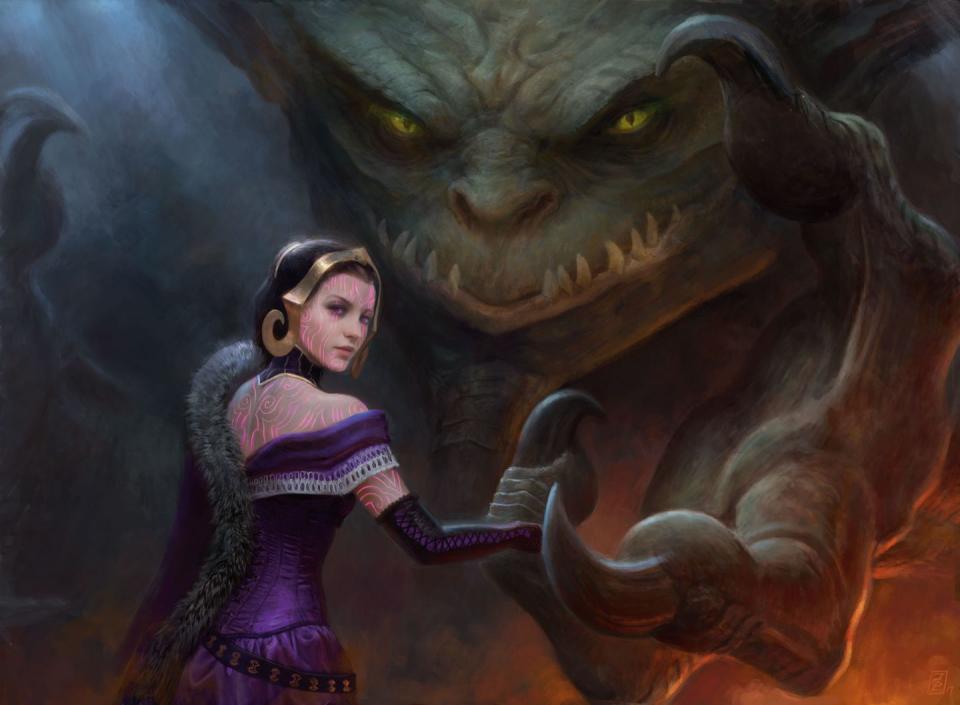
While there are various types of card colors, there are also various types of card types, each with their own mechanics and rules about how they work:
Creature: Your most basic attacker and defender, a creature spell can be anything from a demonic imp to the most pious angel. Each creature comes with an attack and defense rating in the bottom right corner, which signals how powerful the creature is, along with additional abilities listed on the card. These numbers and words help fully form the creature you’ve summoned to achieve victory on your behalf.
Sorcery: Simply put, a sorcery is a spell you cast directly from your hand with a one-time effect that is then discarded. You may only play sorceries on your turn.
Instant: Much like a sorcery, an instant is also played from your hand for a one-time effect. The only difference is that you may play this spell on your turn or your opponent’s turn. This gives the game an extra dimension, allowing you to interact with your opponent even when it’s not your turn.
Enchantment: An enchantment also works like a spell or sorcery, but instead stays in play indefinitely until your opponent can find a way to dispel it. Other enchantments can also include creature enchantments which continually buff (or de-buff) a card until its dispelled or the creature is destroyed.
Artifact: An artifact works in much the same way as an enchantment, but is instead a card that usually represents a physical object rather than a magical spell. Other artifacts can also include equipment, which can make your creatures even stronger. Unlike creature enchantments, equipment stays in play even if the creature is destroyed.
Planeswalker: Sometimes you need some help from your friends. These ultra-powerful cards represent other Planeswalkers (like you) who have come to help you win your battle. These cards come with tokens and work much differently than your more traditional Magic card. We’ll talk more about Planeswalkers later.
How to Get Started
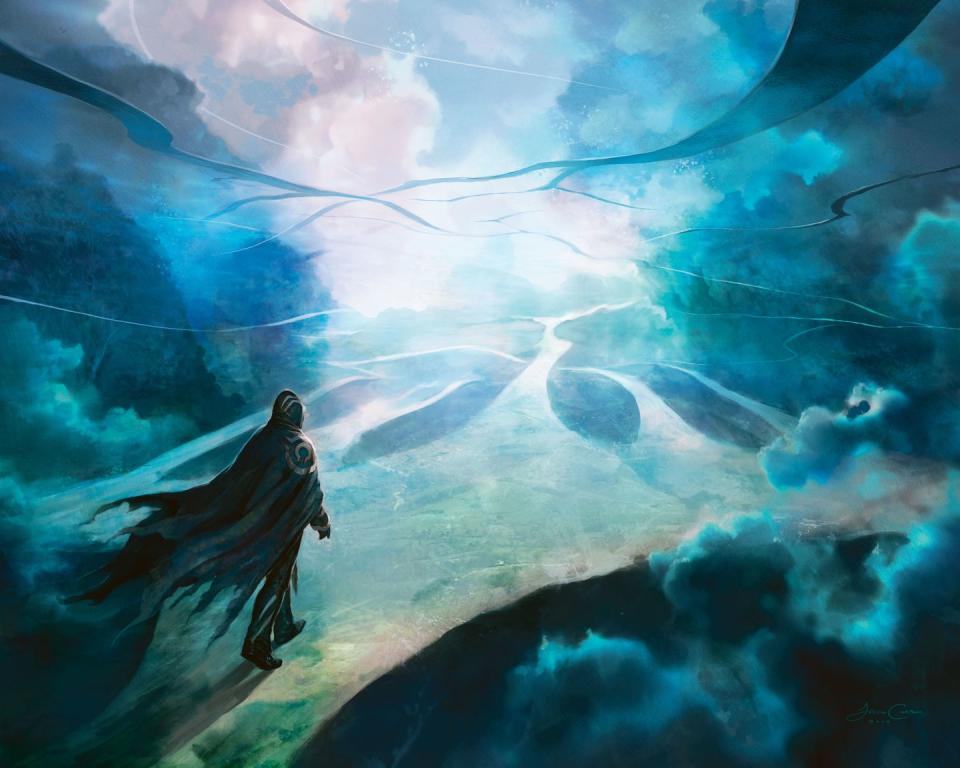
With this basic knowledge, you’re now ready to play your first game. This brings up another important question, what cards should you get? With 84 expansion sets of Magic at your disposal, the sheer volume of cards can be mind-boggling. Luckily, as Magic has expanded, so have its efforts to make newcomers feel welcome.
It’s best (and newest) tool is an online game called Magic: The Gathering Arena. Currently in open beta, MTG Arena is perfect for players who are more comfortable playing online rather than investing in the physical game itself. The game is also free to play (though monetary investments certainly help) and there are thorough tutorials and A.I. matches than can walk you through the basics.
But the traditional way of experiencing Magic is through good, old-fashioned paper stock, and Wizard offers many ways to dip your toe into card collecting without spending too much.
Magic: The Gathering Arena starter kit lets you bridge the gap between digital and physical and provides great instruction on how to play the game. It's the No. 1 place to start learning Magic: The Gathering
Once you’re ready to move on from the starter kit, the best cards to kick-start your collection come from Magic’s annual Core sets with the latest being Core Set 2021. The Core Set helps you collect powerful cards while also helping explain some of the rules with further instructions printed on the card.
Once you’re ready to play something with a bit more skill, Magic’s Planeswalker sets are fully formed decks that you can crack open and play immediately.
Finally, when you’re ready to fully embrace everything Magic has to offer, trying hosting a booster draft with your friends using Magic's most recent expansions.
Anatomy of a Card
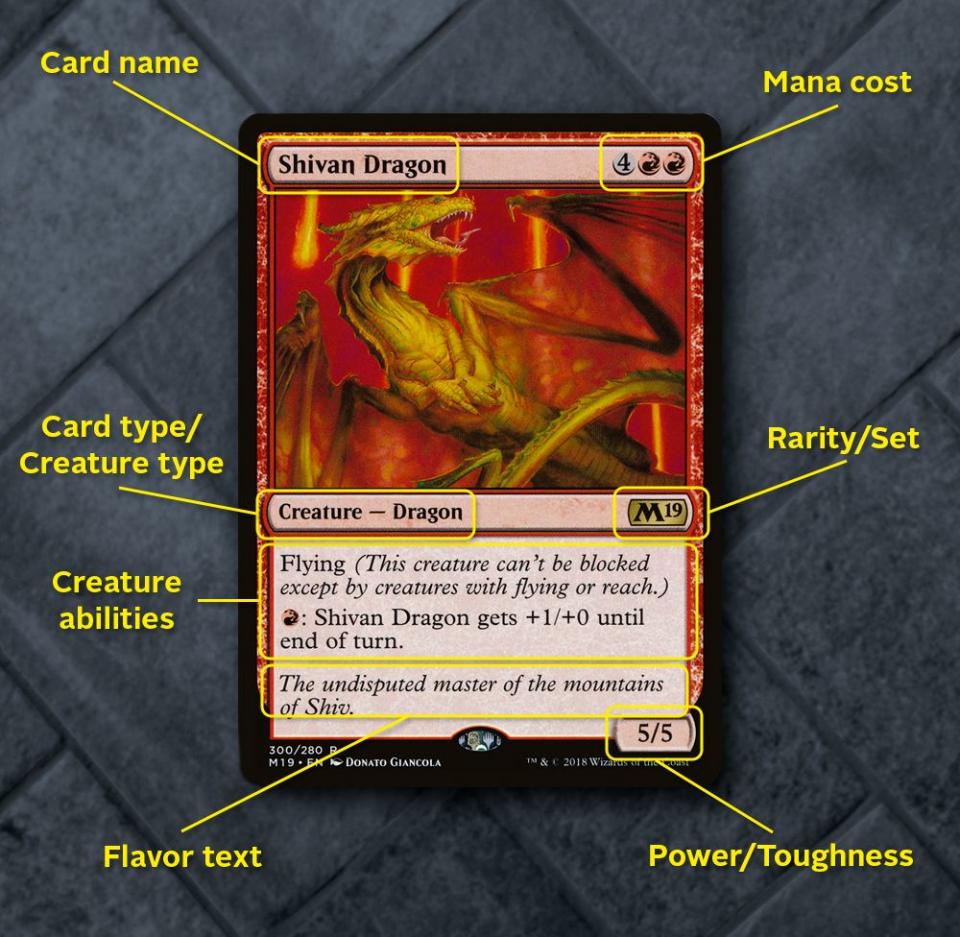
Once you've got some cards, the next step is walking through a simple Magic card and learning what everything means.
In the example above, the Shivan Dragon is a creature card of the Dragon type. In the top right corner, you see the card’s mana cost. This tells a player how much mana or land you need to play this card. The two red symbols mean you need to have at least two mountain mana in addition to four mana of any color to play this card.
If you have enough mana to pay this cost, you can spend the required mana and place it on the battlefield. Remember that creatures have summoning sickness when they first enter the battlefield, meaning they can’t attack until next turn (unless they the haste ability), though they can defend against incoming attacks (more on this later).
The Shivan Dragon’s power and toughness is located on the bottom right, and is a 5/5. This means when you attack, the Shivan Dragon deals 5 damage and it also takes 5 damage to knock its toughness to 0 (thus killing Shivan Dragon and removing it from the game). You also benefit from all abilities listed in the card ability section. In this case, Shivan Dragon gains +1/+0 for every mountain you spend on this ability per turn.
While other creatures and card types have different effects once played, they all follow this same basic mana purchase system. The only difference being that creatures, enchantments, and artifacts stay on the playing field whereas sorceries and instants are placed in your discard pile, also known as your graveyard, after casting their one-time effect.
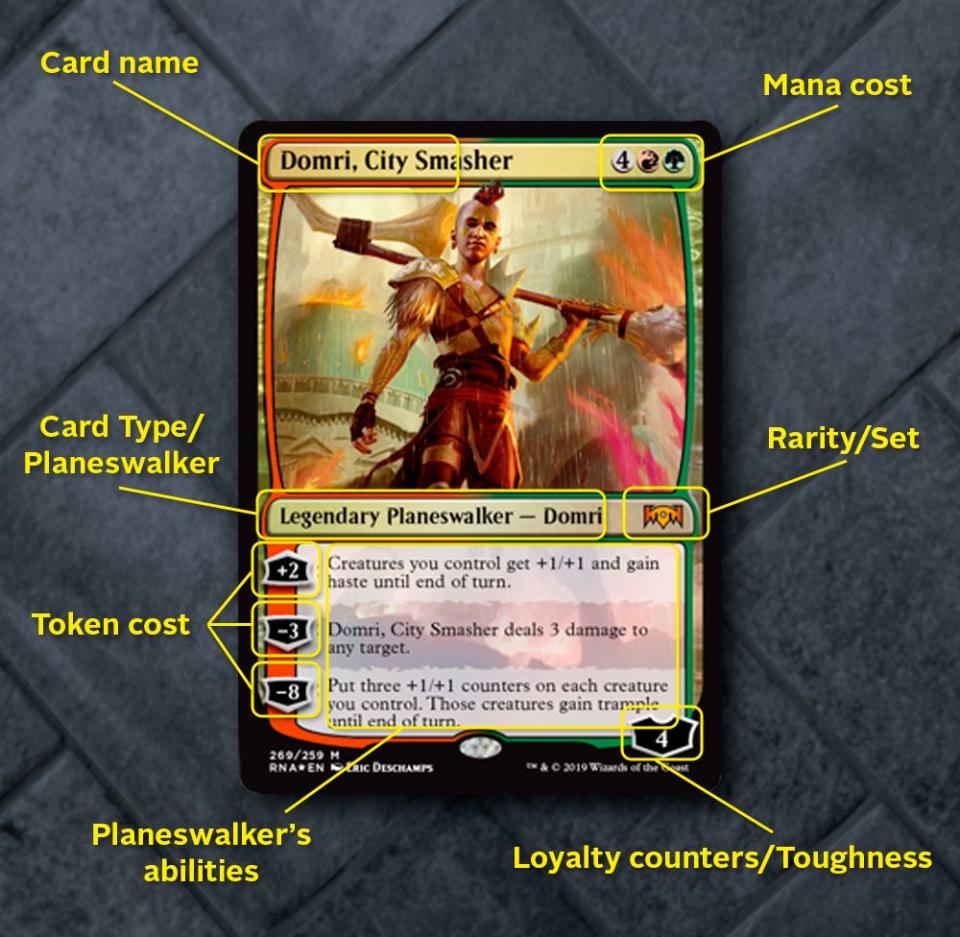
The only cards that work slightly different are Planeswalkers. In this example, a Planeswalker featured in Magic’s in 2019's Ravnica Allegiance Planeswalker set, the mana cost still works much like Shivan Dragon (though you must play a forest and a mountain this time). However, a Planeswalker essentially acts as another player, so when an opponent attacks you, he or she must specify if they are attacking you or your summoned Planeswalker.
Once you pay the mana cost, Domri (your Planeswalker) enters the battlefield with four tokens or loyalty counters (bottom right). Once per turn, you can choose from one of Domri’s abilities, but you need to have enough counters to pay for the effect. While the first ability grants you more counters, the second and third abilities take away counters (but are more powerful effects). In order to use these abilities, you need to spend turns adding counters to Domri, so you can use the card to its full potential.
But these counters also represent Domri’s toughness, so if your opponent attacks Domri and the card suffers damage, you lose one counter for every point of damage sustained. This adds a dimension of strategy to the game where your creatures and spells need to protect you and your Planeswalker.
Playing Your First Game
Walking through an average game of Magic would be a lesson in futility. With so many different cards, spells, and strategies, Magic is a game best taught through watching and playing than careful (and complicated) explanation. Along with the MTG Arena tutorials we’ve already mentioned, Wizards of the Coast has great introductory explainers that explain the very basics. To see a full game play out with step-by-step explanations, check out this video by Geek & Sundry, which tells you everything you need to know to grasp Magic’s basics in less than an hour.
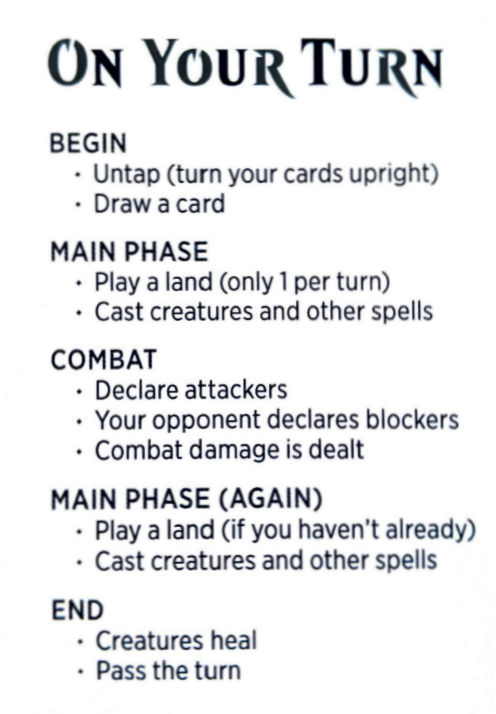
Budget MTG Decks also has a great series of videos highlighting the basics, but you’ll want to pay special attention to the tenth (and final) video in the series, explaining one of Magic’s more complicated components—The Stack. This mechanic is how players determine in what order spells trigger if multiple cards are cast at the same time. So if you play a creature, and your opponent casts a spell that kills it, but you counter that spell, but your opponent counters that counter, the Stack helps you figure out what exactly happened amidst the chaos of all that spell-slinging.
You'll also need to learn how a normal turn works. Magic labels these phases as Begin, Main Phase, Combat, Second Main Phase, and End. The general breakdown, listed on a helpful card (left) you'll find in Magic's starter bundles, breaks down everything so you can see at a glance how your average turn plays out. Several helpful YouTube videos also break down turn phases even further.
Remember these phases only refer to your turn. You can still play instants and creature abilities on your opponent's turn.
Here are a few other rules to keep in mind during your first few games:
Unless a creature has haste, all creature cards have summoning sickness the first round you play them, so they cannot attack until your next turn.
Creatures are also considered spells, so they can be targets for instants and counter spells before they enter the battlefield.
In Magic, your starting hand size is seven. However, you can mulligan if you don’t like your hand at the start of the game, but then your starting hand size decreases by one.
Your maximum hand size is ten. If you ever draw more than ten cards, you must discard down to ten by the end of your turn.
Planeswalkers cannot attack or block. Only their abilities can be used, but they don’t suffer from summoning sickness so they can be used on the first turn you play them.
While there is technically no maximum to how large your deck can be (as long as you can shuffle it), you’ll likely want to stay right at the standard minimum of 60 cards. This assures that you have a great chance of drawing your most powerful cards and combos.
You can only play one land card per turn (unless otherwise specified). This does not include other card types that produce mana as an ability.
To attack or use an ability, players must tap the card (turn it 90 degrees clockwise) to indicate its use (unless the card has vigilance). This card remains tapped during your opponent's turn, which means it cannot be used for defense. At the beginning of your next turn, all your tapped cards untap.
When creatures sustain damage but survive an attack, they return to full health at the start of the next turn. Damage does not carry over from turn to turn.
In most cases, creature abilities can be used like instants, meaning you activate them on your turn or your opponent’s turn (as long as they're not tapped already). This can make combat extra tricky in some cases.
Learning Lore and Leveling up
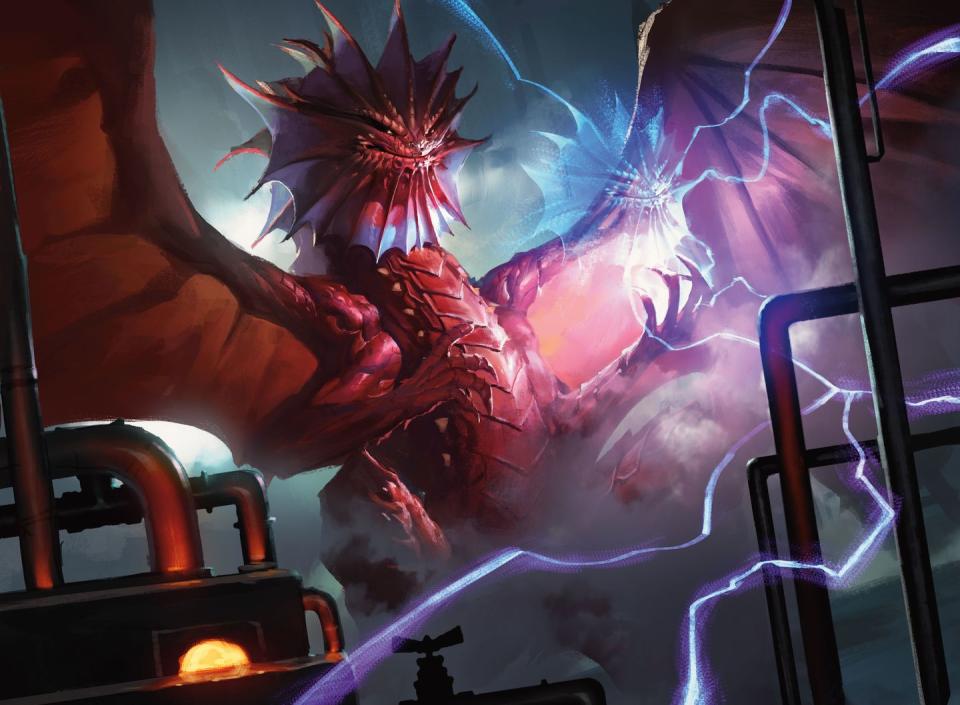
For really getting the most out of Magic, it's worth spending some time learning its lore. Wizards of the Coast doesn't create cards out of nowhere. For most of Magic's history, each set is one part of what is called a block. A block usually contains three sets and tells a cohesive story across those sets. So you don't have to read 25 years of lore in order to understand the story behind the cards you're playing right now.
"It's like we make three big budget movies a year," says Verhey. "We do a ton of creative work. We have a concept artist work for weeks on concept art. We have writers write a bunch of stuff about the world, and we end up with a whole world guide…we can build an entire world around it."
Each new world comes with all its own themes, strife, magic, and complications. While some elements carry throughout each block (Planeswalkers can cross into other realms after all) and Magic game designers often returns to past favorites, every block is mostly a new story to hook new players while keeping Magic veterans interested.
"All of our worlds are inspired by something," Verhey says. "We have Theros, which is a Greek-inspired world. We have Innistrad, which is a Victorian-horror-inspired world, and those are two worlds you will get totally different cards out of."
You can get caught up on all the Magic lore you want online with stories posted directly to MTG's website. It's not a necessary element for playing Magic, but it certainly makes it a deeper experience.
Finally, once you've mastered all the basics but want to learn more, the internet can be a lovely place. Here are few things to check out to continue your Magic education:
Explore Magic's varying formats, which include standard, modern, vintage, legacy, pauper, commander, and many, many more.
Limited Resources is a long-running podcast talking all things Magic: The Gathering, and if you want to go real deep, JudgeCast is a deep dive into Magic rules for Magic judges, the officials who run tournaments.
MTGGoldfish is a great deck-building tool that lets you try out deck ideas before snatching up all the cards (which can get pricey).
For buying specific cards, Channel Fireball and Star City Games are the big online shops. But great deals can be had at smaller outfits like Card Kingdom and TCG Player, which is more like eBay for card games.
But the absolute best advice is to watch others play Magic and learn from them, so find some favorite Twitch streamers. We like MTG pro player Reid Duke because he walks through his decisions while streaming, so you get a glimpse into the thoughts of a pro.
Also, have some fun.
You Might Also Like

